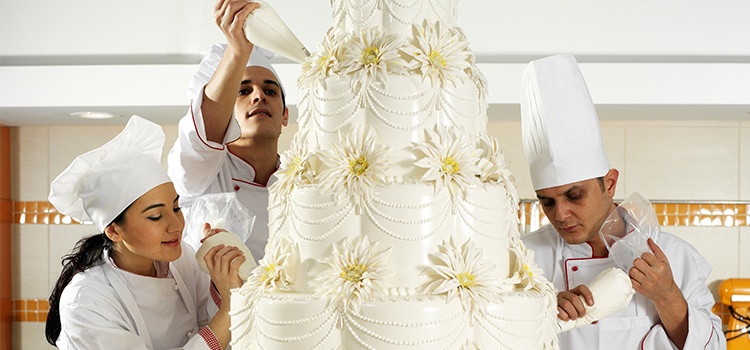The Multilayered World of Wedding Cake Design
Learn how to create professional-looking wedding cakes with these seven key tips.

About Cake Design
Wedding cake design involves much more than flour, butter and some frosting. While delectable flavors are always an essential part of baking, successful wedding cake design includes elements of art, architecture and engineering—in addition to culinary expertise.
These days, wedding cakes run the gamut from traditional to zany. They come in varying shapes, colors, textures, layers and flavors. To succeed at wedding cake decorating and design you'll need the ability to translate the essence of a couple's wedding into a beautiful and edible work of art for their special day.
The Seven Pillars of Wedding Cake Design
1. Design
Step one in creating a beautiful wedding cake design is to determine the overall concept and plan for the cake. You'll meet with the couple to learn their vision for their cake. The conversation should include questions like these: How many people do you want to serve? What is the theme and color scheme of the wedding? For decorations, do you want fresh cut flowers, elaborate marzipan roses or white chocolate lace?
Offer a cake-tasting with a selection of cake types and filling flavors. It helps to have some photos of wedding cakes to help the couple identify what they want and to give them some ideas. As you gain experience, take pictures of wedding cakes you've made and add them to your portfolio.
2. Baking
A wedding cake should taste as least as good as it looks. If you consider a wedding cake as a masterpiece that mixes art and science, then baking is the scientific element. Based on the bride and groom's cake and frosting selection, you need to gather your ingredients and develop a baking plan. You'll need mixing bowls, pans, spatulas, a lot of space and plenty of time. Not to mention a good oven and a spacious refrigerator. Visit cake stores to pick up cardboard cake rounds to support each layer, and cake strips to keep cakes level while they're baking.
3. Frosting
The frosting creates the visual texture of the cake, and you need to consider color, taste and consistency when deciding what kind of frosting to use. The two most common types of frosting for a wedding cake are buttercream and fondant. Either or both can be used to create memorable wedding cakes. When frosting a cake, you should be asking yourself: Is the texture smooth or raised? What type of texture should the cake have to tie it in with the theme? Is there any elaborate scripting to be done?
4. Ornamentation
Wedding cake decorating can be one of the most fun yet stressful parts of wedding cake design, since so much of the success of the cake relies on its visual display. The cake is meant to express the theme of the wedding. To portray the unique feeling of each, cakes are adorned with anything from fresh flowers to beads to plastic figurines. Let your creative spark fly when it comes to decorating, and be sure to leave yourself enough time for this all-important step.
5. Preservation
Just as Rome wasn't built in a day, neither is a good wedding cake. It's a project you'll need to complete in stages. This means that part of your job is to supervise the freezing and thawing of the cake and its pieces in order to preserve the freshness of the end product.
6. Assembly
Cakes are composed of delicate and sometimes slippery ingredients, especially in the hot June weather favored by brides. Here's a tip: one of the best ways to keep cake layers upright and looking perfect is to embed three or four plastic straws through the layers—straws are inexpensive, lightweight and ideal for maintaining a cake's structure.
7. Transport
Transporting the wedding cake to the event is often a nail-biting experience. Yet it's a vital part of a wedding cake design business. The best way to do this is to drive slowly and reduce any friction or extraneous items in your vehicle that could fall on the cake. You can also plan on some assembly at the site. Don't forget to bring along some extra frosting and decorations for last-minute fixes.
Designing Wedding Cakes as a Professional
If you're thinking about wedding cake decorating as a career, you should consider obtaining some formal culinary arts training. By attending a reputable baking and pastry arts program at an accredited culinary school, you will learn new techniques, make future employment contacts and expand your baking vocabulary. Most employers prefer to hire decorators who have both education and relevant experience.
You May Also Like
FIND A CULINARY SCHOOL TODAY
Tell us a little about yourself and we'll connect you with schools that offer culinary arts programs.
